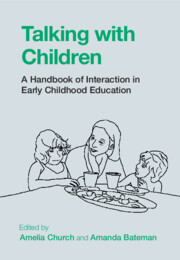Book contents
- Talking with Children
- Talking with Children
- Copyright page
- Dedication
- Contents
- Figures
- Tables
- Contributors
- Acknowledgements
- Notes on Transcription Conventions
- Introduction
- Part I Talk as Social Action
- Part II Pedagogy in Interaction
- Part III Interaction and Inclusion
- 15 Play
- 16 Mental Health and Wellbeing
- 17 Neurodiversity
- 18 Friendships
- 19 Conflict
- 20 Morality
- 21 Families
- Index
- References
21 - Families
from Part III - Interaction and Inclusion
Published online by Cambridge University Press: 16 June 2022
- Talking with Children
- Talking with Children
- Copyright page
- Dedication
- Contents
- Figures
- Tables
- Contributors
- Acknowledgements
- Notes on Transcription Conventions
- Introduction
- Part I Talk as Social Action
- Part II Pedagogy in Interaction
- Part III Interaction and Inclusion
- 15 Play
- 16 Mental Health and Wellbeing
- 17 Neurodiversity
- 18 Friendships
- 19 Conflict
- 20 Morality
- 21 Families
- Index
- References
Summary
The distinct style of human communication develops gradually during a child’s life course. Researchers have reported that caregivers often try to involve young children in culturally and historically developed interaction patterns. Together with colleagues, I conducted a longitudinal study of Japanese caregiver (mainly parents and siblings) – child (0 to 5 years old) interactions naturally occurring at home, focusing on the developmental transition whereby children’s responses become behavioural patterns that meet caregivers’ expectations. The topics of study included managing attention in child pointing and the caregiver’s response, generating morality while caregivers issue directives (i.e. making their children do something), and caregivers’ strategies for eliciting storytelling from toddlers. Based on these findings, I argue that family interactions provide the foundation for children’s language socialization. Moreover, I explore possible ways that caregivers and nursery or preschool teachers can establish a link between family life and educational settings for children in their care. The recommended practices are summarized as (1) caregivers should communicate to teachers about their child’s recent behavioural accomplishments (e.g. pointing); (2) caregivers and teachers should share a list of directives they have used and the child’s responses to them, and so on.
- Type
- Chapter
- Information
- Talking with ChildrenA Handbook of Interaction in Early Childhood Education, pp. 426 - 444Publisher: Cambridge University PressPrint publication year: 2022



